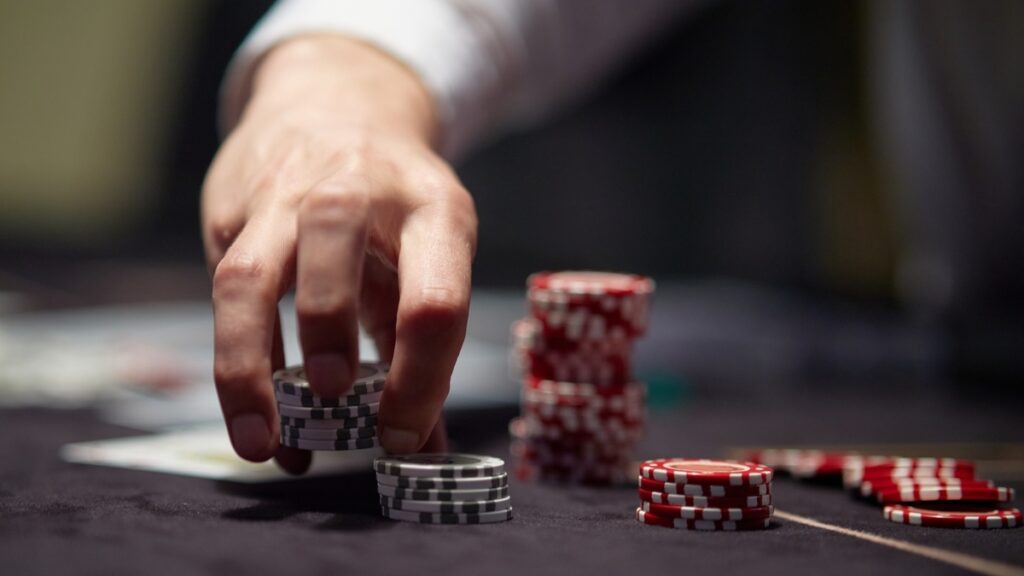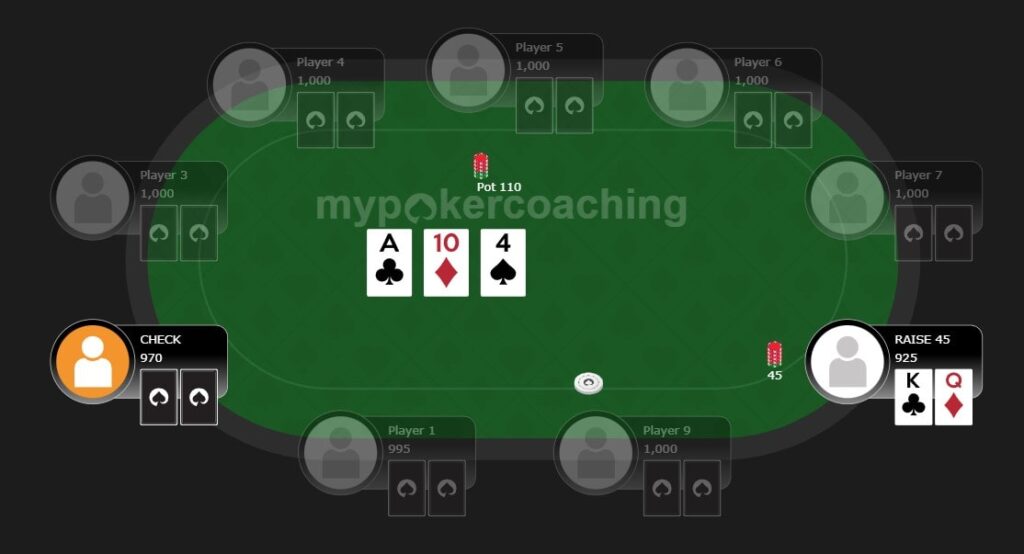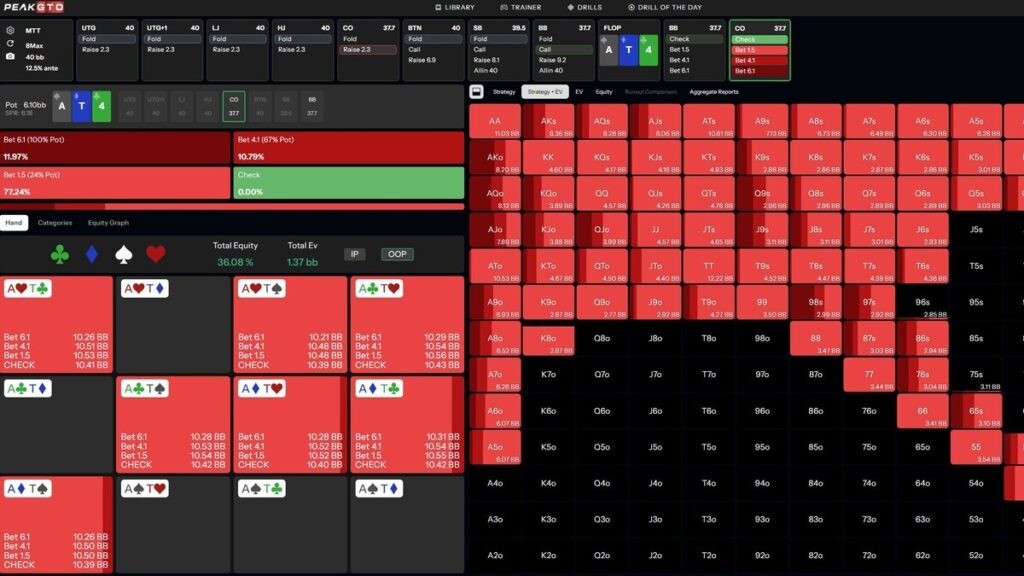Poker is a complex game, offering multiple ways to win pots. While winning with the best hand at showdown is great, winning some pots without showdown is also an essential part of poker.
If you have read our guides on poker odds and poker equity, you should already know how to calculate your equity in a poker hand and compare your equity with your opponent’s.
However, the concept of fold equity allows you to go one step further, taking some of your opponent’s equity by forcing them to fold their hand.
This time around, we will look at how fold equity works in-game and what additional edge we can gain by applying pressure at the right time.
Fold Equity Explained
Fold equity is a fairly simple poker concept. It is the additional equity we gain in a pot by forcing our opponents to fold their cards.
For a very basic example, you can imagine a hand where your opponent has just a 10% chance to win the hand. This means you have 90% of the equity, but not all 100%.
However, in a scenario like this, even a small bet will often force your opponent to fold, thus gaining you the extra 10% equity.
Just like that, you go from winning 90% of the pot to winning 100%, which is a big difference in the grand scheme of things.
Of course, even without thinking about it, poker players apply the concept of fold equity on a regular basis, but understanding it more in-depth will allow you to exploit it even further.
How to Calculate Fold Equity in Poker

Fold equity may sound like an abstract term, but it is actually quite simple to translate it into numbers. The tricky part is getting the numbers right.
While playing a hand, it can be nearly impossible to know exactly what portion of their hand range your opponent will fold.
However, if you take a look at a hand you have played in the past, you should be able to narrow down your opponent’s range and determine which hands they would fold to certain bet sizes.
Playing around with such calculations in the lab can allow you to make better plays intuitively in-game, which is the ultimate goal.
The calculation for fold equity is extremely simple:
Fold Equity = Opponent’s Equity * Percentage They Fold
For example, imagine your opponent having exactly 50% equity in a $100 pot. This means they have 50$ worth of equity.
However, by making a bet, you believe they will fold half of the time. Running the formula above, you can quickly calculate that the bet makes you an additional $25 in equity.
Finding the right times to make bets that can gain you extra equity is the way elite poker players maximize their edge in the games.
Of course, it is worth noting that your bets must also be balanced, as betting too big and too often can mean they you are losing money in the long run. For that reason, you must understand the concept of risk-to-reward ratio.
What Is Risk to Reward Ratio?
Risk-to-reward ratio is another mathematical concept that we can tie in with fold equity to get the best possible results with our bluffs.
It determines the percentage of the time our bet needs to work in order to be profitable. When running bluffs with no equity, risk to reward ratio is the only thing you need to consider.
The formula for calculating it is as follows:
Risk to Reward Ratio = (Bet Size / (Bet Size + Pot Size)) x 100
Let’s put this into practice. Imagine you are playing a cash game hand and there is $100 in the pot. You are considering betting $50 as a bluff, and you want to know how often it needs to work to be profitable.
You would run the formula in your head:
Risk to Reward Ratio = ($50 / ($50 + $100)) x 100
Risk to Reward Ratio = ($50 / $150) x 100
Risk to Reward Ratio = 0.33 x 100
Risk to Reward Ratio = 33%
In this particular case, your bet needs to work 33% of the time to make a profit. You are betting $50, and if you win the pot more than one third of the time outright, you are making a profit, since there is already $100 in the pot.
Of course, things get even better if you are bluffing with equity. For example, if you were bluffing with the nut flush draw in the same scenario, you would still have about 35% equity in the scenarios your opponent decides to call the bet.
Yet, whenever you are not a statistical favorite to win the hand against your opponent’s range, getting them to fold is always the optimal result.
How Fold Equity Works with Hand Equity
Hand equity and fold equity are the two parts of your total equity in any poker hand. Put together, these two represent the entirety of the equity you have in a poker hand.
In the simplest of terms:
Total Equity = Hand Equity + Fold Equity
For example, imagine playing a hand where you flop an open-ended straight draw and two overcards on a board of Ts9s4c. Putting the hand into a hand calculator against a perceived opponent’s range gives you 40% hand equity, which is pretty solid.
However, a glance at the board will tell you that there are hands in your opponent’s range that have plenty of equity against your QJ, but that will fold to a bet.
For example, if your opponent has 22, 33, 55, 66, or 77, they are likely to fold those hands. Furthermore, hands like KQ, KJ, and various Ace-high combos without spades will also have a hard time calling bets on this board.
So, imagine your opponent folds 30% of their range to a full-pot bet in this spot. Your hand goes from having 40% equity to having 70% equity, as the extra 30% fold equity is added to your total.
Bluffing for added fold equity with hands that already have a lot of pure hand equity (such as straight and flush draws) can be a very good idea, as such hands also have extra room to continue building fold equity on turns and rivers.
Using Fold Equity In-Game

Now, let’s take a look at an example of an actual poker hand where fold equity can come in quite handy, whether you play on a mobile poker app or in a live environment.
Playing in a $5/$10 cash game, you open the cutoff to $30 with KcQd, and only the big blind makes the call.
The flop brings AcTd4s, and you are left with nothing but a gutshot straight draw. Many poker players immediately freeze upon seeing the Ace on the flop and automatically check, but let’s look at the situation more closely.
Your opponent’s range in this situation is quite wide. They will have a ton of small pocket pairs and various suited connectors and gappers that have not connected with the board at all.
Their range does not have any AA or TT poker combos, as those would have re-raised preflop, making their strongest possible hands AT and 44.
While your gutshot straight draw may only have about 18% equity against a hand like Ax, it has a lot more equity against your opponent’s entire range. For this experiment, let’s assume you have 35% equity against all the hands your opponent could be holding.
If this were the case, you would only need to generate 15% extra equity to turn things around in your favor. Even a small bet into this $65 pot will easily generate the 15% fold equity, as your opponent will happily fold many pocket pairs and suited connectors on a board that gives you a big range and nut advantage.
In fact, your opponent will likely fold close to 50% of all their hands even to a half-pot bet, which will generate an extra 32.5% equity for you, bringing your total up from 35% to 67.5%.
The truth is that, although the board may not look very favorable for your hand, you can often win this pot with pure aggression, while also improving to a better hand some of the time.
Overall, playing this hand aggressively and maximizing your fold equity will turn things around in your favor and take you from a 35% underdog to a significant favorite in the pot.
Maximizing Fold Equity in Poker Tournaments
While fold equity is an idea that works in both cash games and tournaments, it becomes even more important in a tournament setting.
In tournament poker, chips are worth more than they are in cash games, as losing your last chips means being out of contention for prize money.
For this reason, well-timed aggression can maximize fold equity and allow you to win tons of chips completely uncontested.
This is especially true in some key stages of the tournament, such as near the money bubble, the final table bubble, and during final table play.
If you observe players with small and middling stacks folding too often in such situations, you may think they are playing cowardly, but they are actually playing correct. Thanks to a mathematical model known as the independent chip model (ICM), we know these players are rewarded for their fold during these stages.
However, the fact that they are folding more often than they normally should allows you to play more aggressively and shoot your fold equity through the roof.
Find yourself playing as the big stack at a final table of a poker tournament, or even during the bubble stage. You may find that you can expand your ranges greatly and apply aggression with hands that you would normally never consider playing.
If you are a tournament poker player, remember that the value of a big stack is unmatched in tournament poker, and always keep fold equity in mind when you find yourself playing against shorter-stacked opponents.
Build Up Your Poker Edge with Fold Equity
The best poker players out there know that tight usually isn’t right, and they make aggression a key part of their overall poker strategy.
If you want to get better results in your games moving forward, remember that fold equity is a real thing, and that you can benefit from it.
The next time you play poker, think about how you can increase your equity in hands by adding fold equity to your hand equity, and don’t be afraid to pull the trigger when the time is right.
FAQ
What is fold equity in poker?
Fold equity is the additional equity you can gain by forcing your opponents to fold their hand, thus releasing some of the equity they have in the pot.
How do I calculate fold equity?
Fold equity can be easily calculated with the following formula: Fold Equity = Opponent’s Equity x Percentage of Time They Fold.
What is risk to reward ratio in poker?
Risk to reward ratio is the ratio between the size of your bet and the size of the pot. Calculating risk to reward ratio can tell you how often your bluff needs to work to be profitable.
Does fold equity increase my overall equity in a poker hand?
Yes! You can add fold equity to your hand equity to ascertain your total equity in a hand of poker.
When does fold equity work the best?
Fold equity works best in situations where you have maximum leverage. Think tournament poker bubble stages or final tables for maximum pressure and maximum fold equity.


